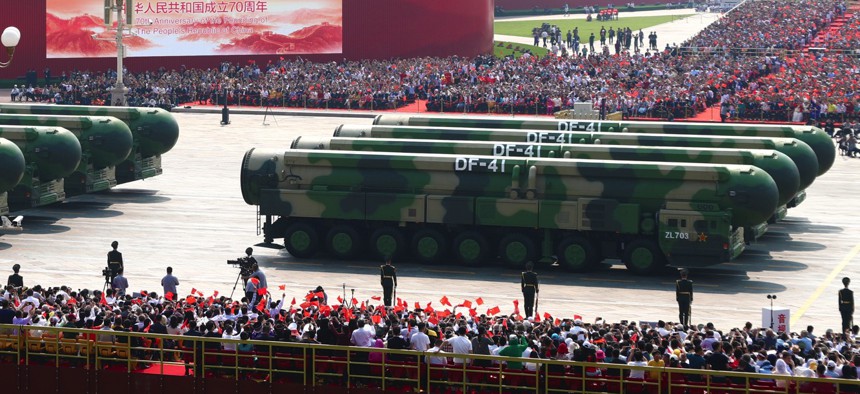MARCUS WEISGERBER

For seven decades, U.S. nuclear weapons policy has largely focused on one nation whose arsenal posed an existential threat: Russia. On Thursday, the Biden administration added China to that list.
The new Nuclear Posture Review reflects Bejing’s efforts to expand and improve its arsenal, a senior defense official said Thursday morning.
“China's nuclear modernization and its rapid expansion presents us with new risks and uncertainties,” the official said, speaking anonymously ahead of the review’s public release. “In the coming years…for the first time, we will have to deter two major nuclear armed competitors, both Russia and China. This presents new dilemmas for both strategic deterrence and for regional warfighting.”
The Congressionally mandated review describes the nation’s nuclear policy, strategy, capabilities and force posture.
“The range of nuclear options available to the PRC leadership will expand in the years ahead, allowing it potentially to adopt a broader range of strategies to achieve its objectives, to include nuclear coercion and limited nuclear first use,” the new version says.
Last year, the Pentagon’s most recent public assessment of China’s weapon programs noted the development of intercontinental ballistic missiles “that will significantly improve its nuclear-capable missile forces.” Beijing is also improving its nuclear bombers and building “at least three solid-fueled ICBM silo fields, which will cumulatively contain hundreds of new ICBM silos.”
Meanwhile, Russian President Vladimir Putin has threatened to use nuclear weapons in its eight-month-old invasion of Ukraine.
“The United States and its Allies and partners will increasingly face the challenge of deterring two major powers with modern and diverse nuclear capabilities — the PRC and Russia — creating new stresses on strategic stability,” the Nuclear Posture Review states.
On Thursday, the Biden administration also released new versions of the National Defense Strategy and Missile Defense Review. The three are typically the most consequential military policy documents released by an administration because they guide strategy and spending priorities for years, if not decades. For example, the Obama administration called for a military rebalance to the Pacific region in 2011. More commonly known as the “pivot to the Pacific,” the strategy was the beginning of an increased focus by defense leaders on countering China’s regional military aspirations and technological weapons advancements.
All three of the documents reiterate previous Biden administration depictions of China as the top concern for U.S. policymakers.
One of them echoes previous invitations to Beijing to enter arms-control talks. As a nuclear power, China “has a responsibility…to engage in talks that will reduce the risks of miscalculation and address destabilizing military dynamics,” the Nuclear Posture Review states.
As for U.S. nuclear weapons, the review calls for retiring the B83-1 nuclear gravity bomb “due to increasing limitations on its capabilities and rising maintenance costs” and canceling a ship-launched cruise missile that was added in the Trump administration’s 2018 Nuclear Posture Review. The Biden administration will keep the W76-2 low-yield submarine-launched nuclear weapon, another Trump addition.
The review endorses the ongoing effort to develop a new ballistic missile submarine and new ICBM and to upgrade the B-52 bomber at a projected total cost of more than $600 billion.
Critics say the existing stockpile provides adequate deterrence.
"[T]he document says the United States has no choice but to build all-new nuclear weapons, despite science-based findings that the current warheads in the arsenal will be reliable for decades to come with only modest maintenance efforts,” wrote Stephen Young, senior Washington representative for the Global Security Program at the Union of Concerned Scientists. “It abandons the pledge Biden made on the campaign trail to declare that the sole purpose of U.S. nuclear weapons is to deter nuclear attacks on the United States and its allies.”
No comments:
Post a Comment